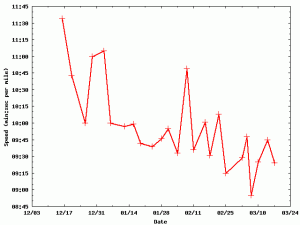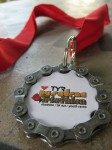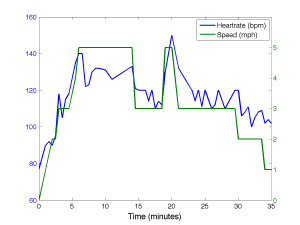The joy of running
March 17th, 2012 at 11:18 pm (Exercise)
I really never thought I’d be one of those people who would go running for its own sake. The pounding abuse to your feet, knees, hips, and the seemingly pointless expenditure of effort for… what? Getting back to where you started, usually.
But since I started training for a triathlon, it seems I’ve gotten hooked.
Running takes effort, and dragging yourself out of bed or off the couch takes maybe more effort, but once you’re out there, this delicious sort of zen descends and you’re zooming along like nothing can touch you. This is a particularly good antidote for those of us prone to unproductive, anxiety-based mind-loops. And when you’re done, you may be tired, but you feel GREAT! Endorphins, accomplishment, fresh air, who knows? It’s all good.
Beyond that, there’s the positive reinforcement angle of seeing measurable progress and increase in your abilities. I started training in December and was able to see the time it took me to run a mile steadily drop (click to enlarge):

Three months in, I’ve shaved 2 minutes off my mile!
I’ve discovered other things I enjoy about running, too: the smell of night-blooming jasmine; spotting Mars, Venus, and Jupiter; seeing my neighborhood away from the computer. Boy, there are a lot of people who walk dogs around here!
And this training process has wreaked changes on my body. My calves are their own, defined muscles. I can see, and feel, the increased muscle tone throughout my legs. I feel like a superwoman at Jazzercise, where a one-hour workout that used to wear me out now leaves me bouncing with energy — so much so that I’ve started doing runs afterwards to help round it out.
Another side effect is that I’ve been eating what seems like a ridiculous amount. Usually I’m not hungry after a run, but the next day, I can’t stop eating. The website where I track my runs estimates that I burn 200-300 calories after a 3-mile run, but I’m *definitely* eating way more than that to compensate — more like an extra 500-600 calories each day. (Plus, I don’t run every day, more like every 3 days.) Yet I’m not gaining any weight. I guess some of it must go to the muscle building process, but where’s the rest? Maybe this kind of exercise does increase your basal metabolism, so I’m burning more calories even when I’m stuck at my desk?
My next goal is to work up to a 10k (6 mile) run. The longest I’ve done is 4 miles, so I’ll need to start lengthening my practice runs and building more endurance. I’d also really like to get below 9 min/mile for a 5k. (The ~9 min/mile data point on the chart was from a short 1.25-mile run.) I love concrete, measurable goals!


